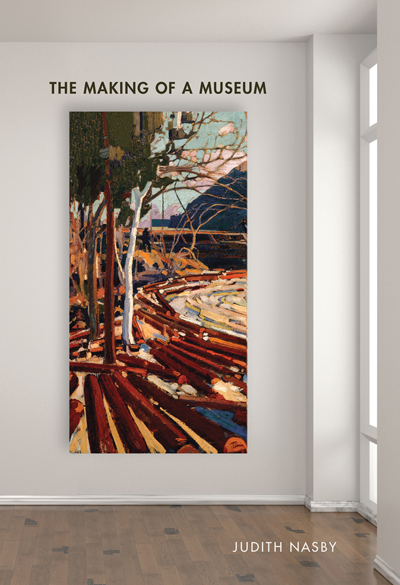
Nasby, Judith. The Making of a Museum. McGill-Queen’s University Press, 2001, $49.95
Judith Nasby’s book, The Making of a Museum, is an account of her career of over fifty years as founding director and curator of the Macdonald Steward Art Gallery in Guelph (now the Art Gallery of Guelph). It is written in chronological order and is beautifully illustrated and filled with valuable information. Beginning with the early roots of the Ontario Agricultural College in the early 20 th Century and the desire of the more visionary faculty to collect artwork, it moves on to Nasby’s first job in the late 1960s when the need arose to hire someone to organize and keep track of the work spread over the newly founded University of Guelph campus. As the University grows so does the scope of the book as it expands in response to Nasby’s vision to reflect major movements in Canadian and International Art. It details the development of permanent collection specializations and concludes with the creation of a world-class sculpture garden. The book also includes an impressive appendix of exhibitions and gallery publications.
Nasby’s love of the arts and her sense of humour permeate the book. Her quiet determination to build a major art collection that would be unique to a small town in Ontario is admirable as is her confidence and vision, particularly in light of the fact that she started all of this in her early 20s. Never stuffy, extremely well researched and informative, the book gives details that only someone so close to the art and artists could know and includes many funny and interesting adventures that Nasby had along the way. These include standing up to wealthy art collector, Ken Thompson and refusing to sell him a major work by Group of Seven artist, Tom Thompson, then having to rescue the piece from being damaged by students playing touch football in front of it. Undaunted by the lack of a gallery, she mounts an exhibition of major Canadian sculptor, Sorel Etrog in a University corridor. After an exhibition of the work of celebrated Contemporary American artists in the University library, and lacking funds, she drives to New York with this valuable collection in the back of the family station wagon. Always one to seize an opportunity, she finds major funding for the establishment of the Macdonald Stewart Art Centre all because of a sick cat.
Once the Macdonald Stewart Art Centre was established, Nasby shaped its mandate as it grew along with the University of Guelph and expanded beyond its roots. She partnered with many talented artists and educators at the University as well as the Guelph Jazz Festival. In one unique collaboration, an exhibition of Aganetha Dyck’s artwork featuring a wedding dress encased in honeycomb created by live bees, she partnered with the University of Guelph’s Apiary Division to drill a hole in the exterior wall of the gallery so the University’s bees could contribute. Nasby’s account of her career moves on from collecting and exhibiting artwork to fostering creators and curators she has worked with over the years. She shaped the mandate of the gallery to be unique to its location in Guelph, Ontario focussing on historical and contemporary Canadian and Indigenous Artwork and work by regional artists who have reached a high level of achievement. While always keeping up with Art movements in Canada and Internationally, she never lost touch with the Guelph community. In addition to building a strong educational program, Nasby encouraged work by artists whose roots were in Guelph such as Lois Etherington Betteridge, David Rokeby, Rolph Scarlett, Seth and many others. She saw the work of Indigenous artist, Richard Bedwash, at the Ontario Reformatory in Guelph and gave him the materials to continue his painting. This resulted in nineteen stunning works that were added to the two pieces by Norval Morrisseau, creating the foundation for a significant First Nations Art collection.
In addition to being a fascinating account of a quietly remarkable career, this book has a broad appeal to research in areas such as Museum Studies, Art History, Canadian Art and International Art, Rural Studies and the history of the Ontario Agricultural College. It is highly recommended as essential reading for anyone connected to the University of Guelph,
PATRICIA FLOOD, School of English and Theatre Studies, University of Guelph
Forthcoming in University of Toronto Quarterly Review – Letters in Canada, 2025